We’re pleased to share a recent blog post from the Manchester Sacred Harp group, written by regular singer Harriet Monkhouse. The Manchester group has been active in projects such as Laurie Anderson’s ARK, which we’ve written about here on SingLoud.org, and their new blog is already highlighting the deep history of the tradition. While SingLoud.org should be a place where new singers can find good information for beginners, we also want to go extremely deep into the history and tradition of the music and the people who have brought us to today. We encourage readers to visit the Manchester site directly to leave comments and join the conversation:

Denson Family Footprints
This is one for the geeks! Earlier this year, someone asked why the song on page 422 of the Sacred Harp book (1991 edition) is called Burdette, and someone else said “I think it’s one of the Denson family.” I couldn’t resist; I plunged down a very deep rabbit hole. I emerged clutching a family tree for all the 16 Densons/Denson relatives who composed songs in that edition, and a list of their 57 songs. As a bonus, when I could find them, I’ve given explanations of song titles not drawn from the lyrics (usually family members, friends, places). If anyone can fill the gaps, I’d love to know!
It’s taken a while to finish, because I felt some words were necessary to introduce the family tree and the song list. So I started reading books – Buell Cobb’s The Sacred Harp: A Tradition and Its Music and Like Cords Around My Heart, plus David Warren Steel’s The Makers of the Sacred Harp.
This is a brief round-up of Denson-related composers, not a biography of the family. But I wish someone would write that, as part of the history of the American South. The man at the top of the tree, William Denson, sold some property in April 1840 (the year he died) to discharge a debt; it included 125 acres of land, four horses, several cows and pigs, and “one negro woman by the name of Harriet about 30 or 35 years old”. When Erin Johnson-Williams visited Manchester to talk about Sacred Harp history, she told us enslaved people sometimes sang alongside slave-holders. I often wonder if Harriet sang with the Densons.
William’s second son, James, is the first Denson to appear in a Sacred Harp book, in 1844, with a Christmas Anthem. But the third son, the Rev. Levi, who had helped expel the Cherokee from their lands in Georgia in 1838, was the ancestor of most of the Sacred Harp Densons. (That’s the grim stuff noted, and I can’t hold sins of the fathers against their children.)

It’s in the next generation that the Densons and Sacred Harp really converge. The dynasty was established with two marriages linked to my entry point, Burdette. Two sisters, Sidney and Amanda Burdette, married two Denson brothers, Seaborn and Thomas. Tom was only 15 when he led a 30-minute lesson at the Chattahoochee convention of 1878. By the end of the year, he and Amanda (17) were married; their older siblings had married in 1874. (There’s a great photo of Tom, Amanda and their descendants, plus one photo-bomber, around 1904 on the Encyclopedia of Alabama website.)
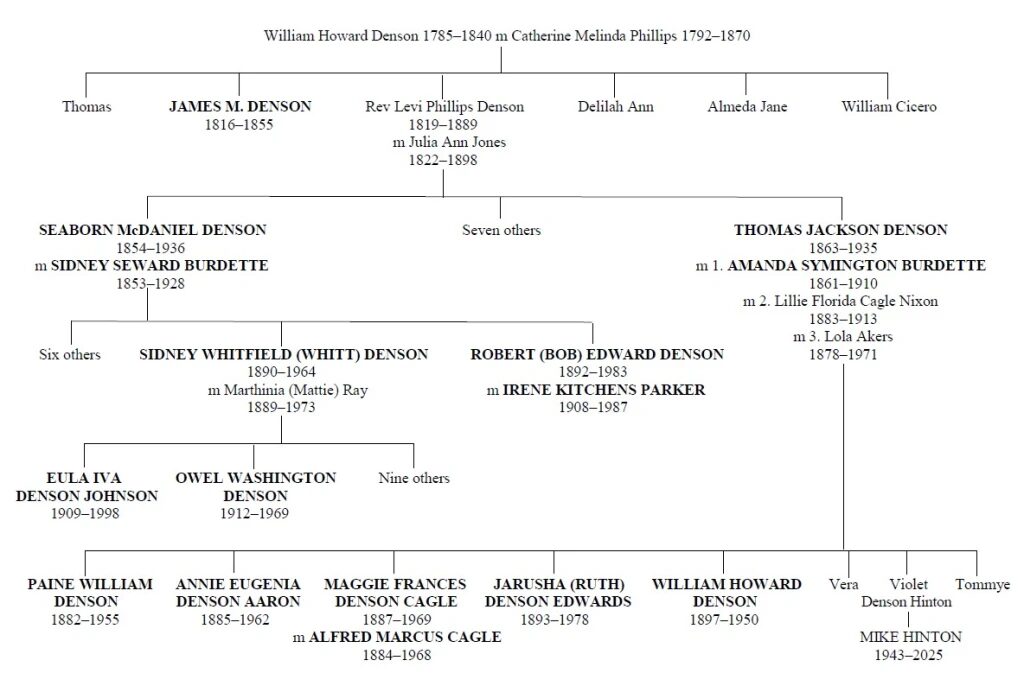
Seaborn and Tom alternated between farming and travelling through Georgia and Alabama to hold singing schools. “Uncle” Tom was believed to have taught more Sacred Harp singers than anyone else. Seaborn is credited with adding many alto parts to originally three-part songs in the 1911 Original Sacred Harp, assisted by his alto sister-in-law Amanda. Sidney is thought to have chosen the Bible quotes below the titles of each song.
In 1933, Seaborn and Tom bought the rights to the book. They started work on the “Denson revision”, which came out in 1936. But both died in the months before it was completed, so Tom’s son Paine got it to press.
Sidney, Seaborn, Amanda and Tom all had songs in the 1991 edition. I noticed that Sidney and Amanda wrote their own words, rather than using existing texts – I’m not sure whether this relates to David Warren Steel’s statement that they had “a more thorough education” than their husbands!
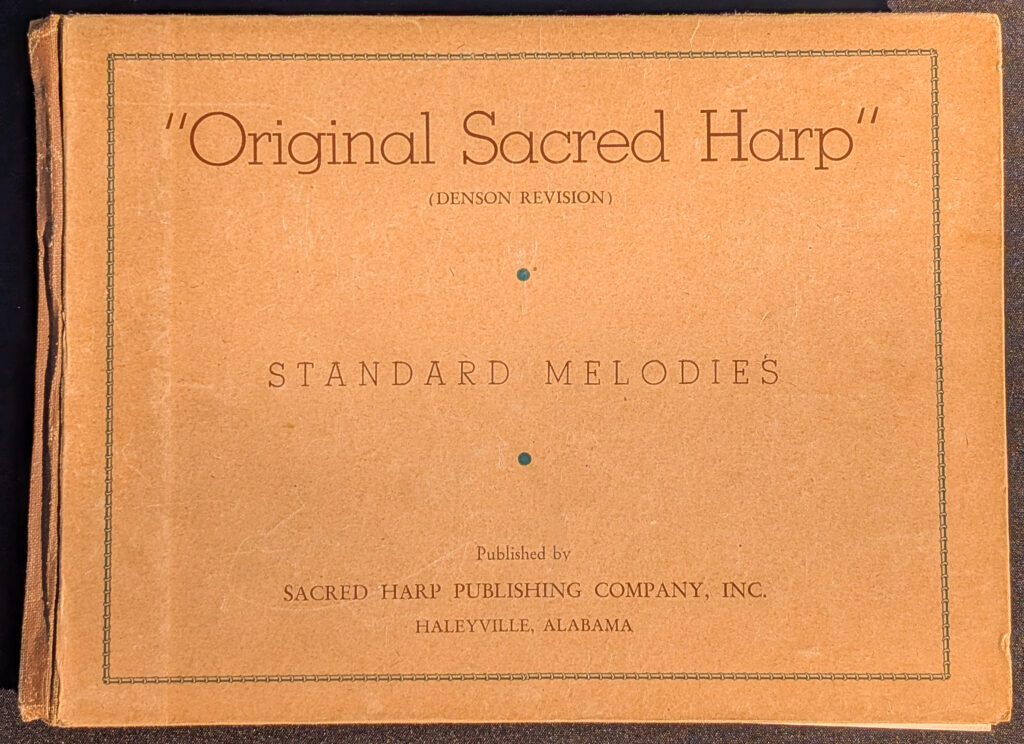
The family’s next generation is well represented. Two of Seaborn and Sidney’s children and five of Tom and Amanda’s appear in 1991, plus two spouses. The most prolific composers are Paine Denson and his sister Maggie’s husband A. M. (Marcus) Cagle, with a dozen songs apiece. Paine loses three in 2025, though thankfully Manchester survives. (The title commemorates the town in Alabama where his father died, rather than our own glorious city.) Marcus Cagle had worked on Tom’s farm before becoming his son-in-law – and later his brother-in-law, during Tom’s brief second marriage to Marcus’s sister Lillie Cagle Nixon. (In a helpful gesture to genealogists, women tacked married surnames on to maiden surnames; Lillie’s set signifies that she had previously married a Mr Nixon.)
Both Cagle-Denson marriages ended in divorce. So did that of Ruth Denson Edwards, another of Tom and Amanda’s children. Reputedly she packed up Lewis Edwards’ belongings and left them on the porch after hearing of a “dalliance”. Described by Hugh McGraw as “a Queen of the Sacred Harp”, Ruth combined her career as a schoolteacher with devoted service to Sacred Harp, as an authoritative leader at singings and secretary of the Sacred Harp Publishing Company. And it would be worth reading Like Cords Around My Heart just for Cobb’s childhood memory of Miss Ruth’s idiosyncratic method of getting her hair cut at the men’s barbershop.
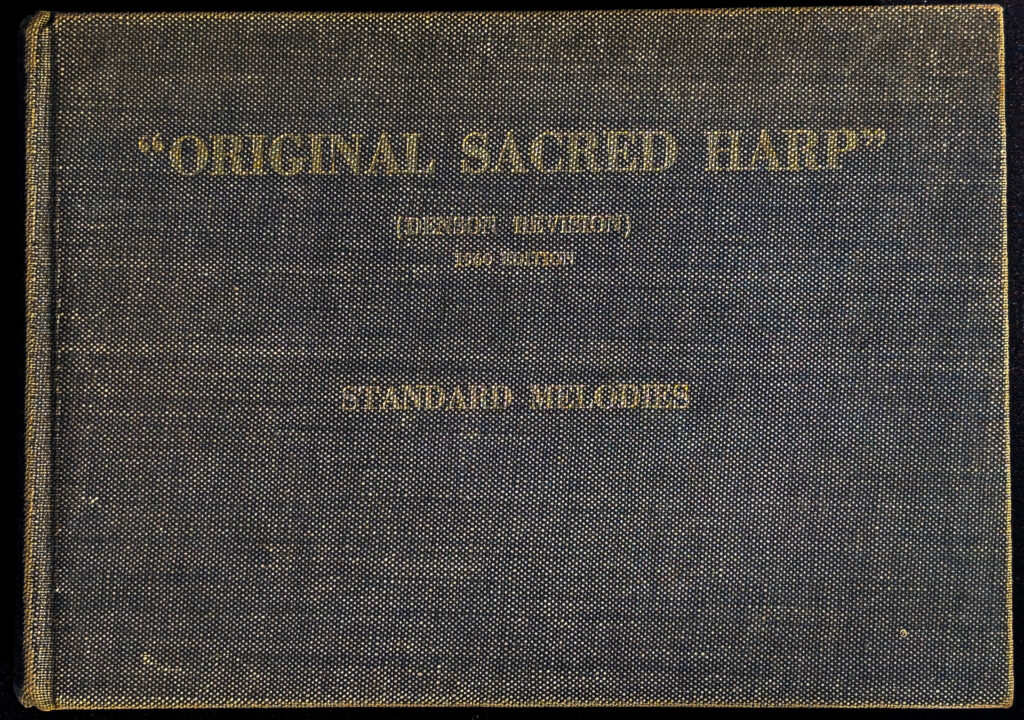
I am touched that Ruth’s sister Maggie and her cousin Whitt Denson both dedicated songs to their mothers-in-law; Whitt also wrote two songs named after his mother. Two of his children, Eula and Owel, feature in 1991. Owel edited the 1960 book, notorious for its poor binding – he’s supposed to have thrown a copy at the wall trying to convince Hugh McGraw it wasn’t that bad.
In the 2025 Edition, four Denson composers—all women, including Sidney—will disappear, and twelve of their songs will be removed. You’ll see Mike Hinton’s name added to the family tree. Though he never composed a song, Mike was Tom Denson’s grandson and served as president of the Sacred Harp Publishing Company from 2002 until his death on July 18, 2025. His inclusion acknowledges his leadership and his pivotal role in preserving and continuing the Sacred Harp tradition.
In the family tree above, the sixteen Denson relatives who contributed songs to the 1991 edition are shown in bold capital letters. I’ve omitted other relatives for space, but I’ve added Mike Hinton because of his importance to recent Sacred Harp history. In the following section, for each composer I give the songs that still appeared in the 1991 edition (some wrote more in earlier books) and note which ones will be dropped in 2025.
I hope there are other geeks who will find this data interesting, but at least I enjoyed compiling it!
(SingLoud.org Editor’s note: THERE ARE, Thank you!)
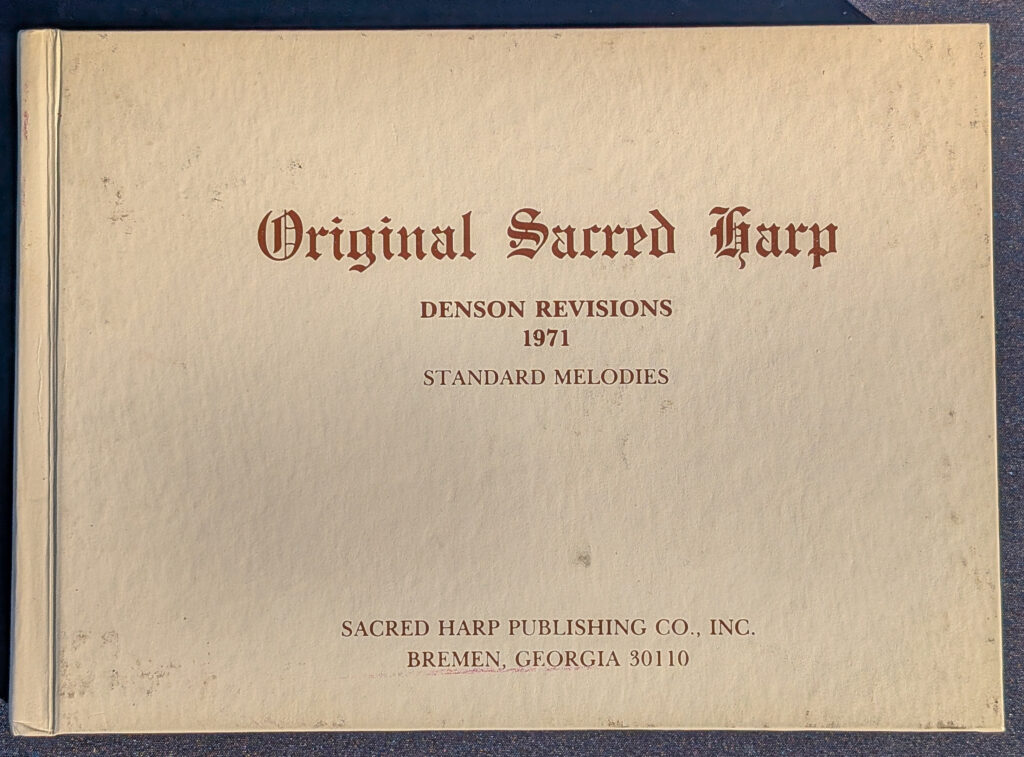
The Denson Family and Their Songs
I originally drew up this list from the invaluable fasola.org indexes, but the links included here are to Sacred Harp Bremen, because that provides words, music and links to YouTube performances of most songs, or robot versions if they couldn’t find a recording. I thought readers might like to be able to listen to less familiar songs.
First generation
JAMES DENSON (1816–1855)
Brother of Rev. Levi Phillips Denson and uncle of Levi’s sons Seaborn and Thomas, he has the earliest song by a Denson, in 1844 (225b Christmas Anthem)
Second generation
SEABORN MCDANIEL DENSON (1854–1936)
Son of Rev. Levi and brother of Thomas. Credited with nine songs in the 1991 edition (153 Resurrected, 208 Traveling On, 314 Cleburne, 328 Praise God, 331 Jester [words and music], 336 Eternal Home, 430 Arbacoochee, 433 McKay, 436 Morning Sun)
Seaborn and Tom were born in Arbacoochee, which is in Cleburne County, accounting for 430 and 314; Jester and McKay commemorate N. D. Jester and the Rev Samuel McKay, both of Alabama.
Jester and McKay are dropped from the 2025 edition.
SIDNEY SEWARD BURDETTE (1853–1928)
Seaborn’s wife, sister of Amanda. Sidney has one song in 1991 (438 The Marriage in the Skies), and is credited with the treble in 153 Resurrected (above). She is said to have chosen the biblical quotations attached to each song from the 1911 edition.
The Marriage in the Skies is dropped from 2025.
THOMAS JACKSON DENSON (1863–1935)
Son of Rev. Levi and brother of Seaborn. Famous as a teacher of Sacred Harp, and worked on the 1936 edition completed by his son Paine. He has eight songs in 1991 (293 Akers, 302 Logan, 340 Odem, 380 Lawrenceburg, 382 Coston, 397 The Fountain, 411 Morning Prayer, 426b Jasper)
Akers is the family name of his third wife, Lola. Odem commemorates Lonnie Odem, a businessman who helped to finance the 1936 revision. W. T. Coston was from Dallas, but I don’t have any more details on him, and I haven’t found an explanation of Logan. Lawrenceburg is in Tennessee, where Tom lived for a while; Jasper is in Alabama, close to Manchester, where he died.
Akers is dropped from 2025, but the Odem omitted is a different song, composed by Leon McGraw.
AMANDA SYMINGTON BURDETTE (1861–1910)
Tom’s first wife. Amanda has one song in 1991 (426t Kelley); like her sister, Sidney, she contributed words and music. I haven’t worked out who or where Kelley was, but you can hear it on YouTube, led by Tom Sprackland of our local Sacred Harp dynasty!
Third generation
SIDNEY WHITFIELD (WHITT) DENSON (1890–1964)
Son of Seaborn and Sidney. Whitt has three songs in 1991 (422 Burdette, 437 Sidney, 493 Amanda Ray)
Sidney and Burdette are his mother’s forename (as well as his own) and maiden name. Amanda Ray was the mother of Whitt’s wife, Mattie – perhaps her surname is given to distinguish her from his aunt.
Sidney and Amanda Ray are dropped from 2025.
ROBERT EDWARD (BOB) DENSON (1892–1983)
Son of Seaborn and Sidney, brother of Whitt. Bob has one song in 1991 (505 Where Ceaseless Ages Roll); the words may be by his nephew, Owel.
IRENE KITCHENS PARKER DENSON (1908–1987)
Bob’s second wife. She has one song in 1991 (545 The Pilgrim’s Way)
Dropped from 2025, but Irene’s younger sister, MARY KITCHENS GARDNER (1924–2013), who previously appeared in 1960 but was dropped in 1991, is back with Youthful Blessings.
PAINE DENSON (1882–1955)
Son of Thomas and Amanda. Paine completed the 1936 edition of Sacred Harp after his father and uncle died. He has 12 songs in 1991 (292 Behold the Savior, 294 Rocky Road [words and music arr. with J. C. Brown], 330t Horton, 330b Fellowship, 392 Manchester, 396 Notes Almost Divine, 447 Wondrous Cross, 502 A Charge to Keep, 518 Heavenly Anthem, 524 The Twenty-Third Psalm, 532 Peace and Joy, 553 Anthem on the Beginning)
Horton is the surname of Paine’s second wife, Mary, and its second verse is attributed to his mother, Amanda. Manchester (Walker County, Alabama) is where Paine’s father Thomas died, so 392 commemorates that settlement rather than our Manchester.
Horton, A Charge to Keep and The Twenty-Third Psalm are dropped from 2025.
ANNIE DENSON AARON (1885–1962)
Daughter of Thomas and Amanda. Annie has one song in 1991 (367 Consolation); she wrote the words and music.
Dropped from 2025.
MAGGIE DENSON CAGLE (1887–1969)
Daughter of Thomas and Amanda, wife of A. M. Cagle. She has one song in 1991 (26 Samaria – the first in the book!) named after her mother-in-law Samaria Duke Cable.
ALFRED MARCUS CAGLE (1884–1968)
Maggie’s husband (until they divorced). He was a leading figure in Sacred Harp for many years, and was chairman of the music committee for the 1960 edition (and also involved in the 1966 version). He has 12 songs in 1991 (316 New Hope, 318 Present Joys, 439 Jordan, 455 Soar Away, 456 Sacred Mount, 462 Faith and Hope, 507 Sermon on the Mount, 522 Ye Heedless Ones, 536 Sweet Majesty, 542 I’ll Seek His Blessings, 550 Blissful Dawning, 573 Harpeth Valley – the last song in the book)
Most of his titles come from the text, but Harpeth Valley is in Tennessee.
JARUSHA HENRIETTA (RUTH) DENSON EDWARDS (1893–1978)
Daughter of Thomas and Amanda. Her original name was the biblical Jarusha or Jerusha, but she managed to convert her nickname “Roosh” to “Ruth” while at school. She has three songs in 1991 (446 Infinite Day, 534 New Georgia, 543 Thou Art God)
Her brother Paine may have written the words of New Georgia, which presumably refers to the place in Paulding County, Georgia, rather than the one in the Solomon Islands!
HOWARD DENSON (1897–1950)
Son of Thomas and Amanda; variously listed as William Howard Denson and Howard Burdette Denson, so maybe he was really WHB. He has one song in 1991 (373 Homeward Bound)
Fourth generation
EULA DENSON JOHNSON (1909–1998)
Daughter of Whitt Denson. Eula has one song in 1991 (491 Oh, What Love); she wrote the words and music.
Dropped from 2025.
OWEL WASHINGTON DENSON (1912–1969)
Son of Whitt Denson, and editor of the 1960 edition. He has one song in 1991 (477 Lord, We Adore Thee), for which he wrote words and music.
Another song, dropped by 1991, was called Seaborn after his grandfather; apparently it was a “companion piece” to 434 Fillmore, reworking the tune in a minor key.
We are grateful to Harriet Monkhouse for her gracious permission to share her terrific work here. Please remember that conversation and discussion are best carried on at the Manchester blog itself, where this piece was originally published:

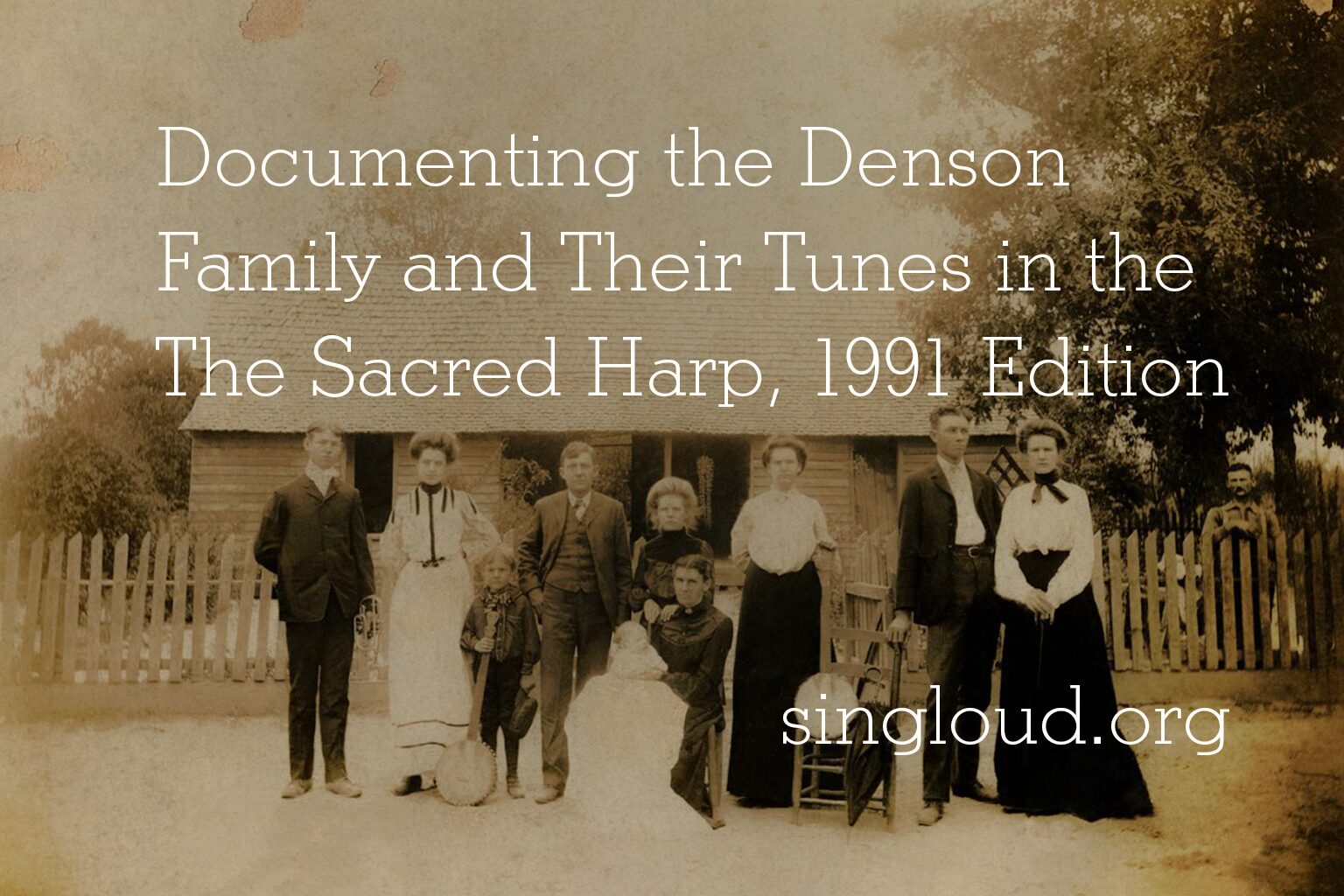
Leave a Reply